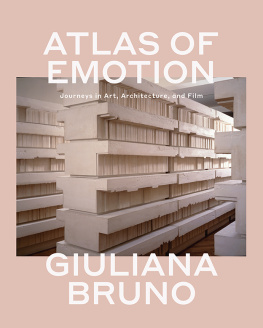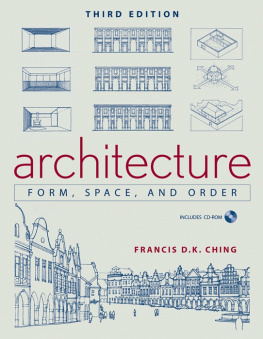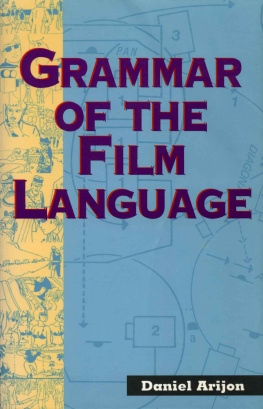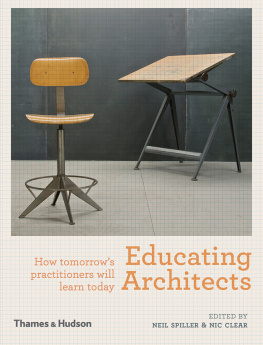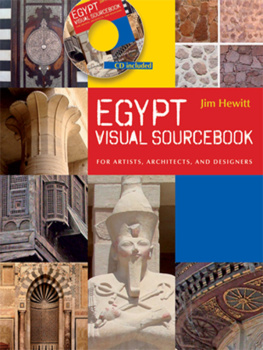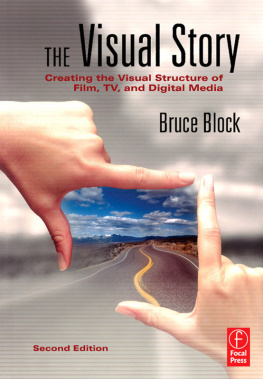
First published in the UK in 2013 by
Intellect, The Mill, Parnall Road, Fishponds, Bristol, BS16 3JG, UK
First published in the USA in 2013 by
Intellect, The University of Chicago Press, 1427 E. 60th Street,
Chicago, IL 60637, USA
Copyright 2013 Intellect Ltd
All rights reserved. No part of this publication may be reproduced, stored in a retrieval system, or transmitted, in any form or by any means, electronic, mechanical, photocopying, recording, or otherwise, without written permission.
A catalogue record for this book is available from the British Library.
Cover designer: Holly Rose
Copy-editor: MPS Technologies
Production manager: Jelena Stanovnik
Typesetting: Contentra Technologies
ISBN 978-1-84150-711-8
ePdf 978-1-78320-211-9
ePub 978-1-78320-212-6
Printed and bound by Hobbs, UK
Table of Contents
Scene 1. Citizen Kane
Scene 2. Citizen Kane
Scene 3. Citizen Kane
Scene 4. Citizen Kane
Stage 1. Cinematographic analysis of film
Stage 2. Filming space
Stage 3. Storyboarding spaces
Stage 4. Storyboarding architectural events
Stage 5. Design proposals
Graham Cairns book is an innovative and welcome addition to the dialogue between cinema and architecture. Recently established as a field of research, this interdisciplinary terrain is relevant to other disciplines beyond architecture and film. Its influence is already evident in established fields such as history, geography and cultural and language studies, but it is also gaining ground in other areas. This book is an opportunity to explore the alternative and complementary intelligence this field opens up, and which can be injected at various stages of creative design processes.
Particularly relevant to architects, this form of cinematic intelligence operates at many different levels corresponding to two principal ways of exploiting the richness of the long history of cinema: through its content and its form. Indeed cinema as an agent, product and source of history (after Marc Ferro), is a formidable resource from which to draw. Although this book is primarily focused on form, its exploitation of the films content is most evident in Part 1 where we are invited to visit or revisit some of the classics.
No serious study of the rise of modernism in France could avoid studying Playtime (1967) to understand both the urban fabric of the modern city and their accompanying societal changes. Jacques Tatis filmic oeuvre is not only a humorous and gentle critique of the modern movement but also constitutes a formidable chronicle of urban transformations undergone in post-war France. Similarly, with Antonionis Zabriskie Point (1970) Cairns reminds us to revisit the film while re-reading Robert Venturi and Kevin Lynch, to which one could add the West coast urban theorists. As this book does, these theorists would no doubt have hailed the astonishing driving sequences in Zabriskie Point as cinema inventing new forms of perception to grasp a world Los Angeles for which we do not yet posses the perceptual equipment to match this new hyperspace (after Jameson).
In other words, the content of films is often a wonderful companion to elucidate, elicit and complement writings on urban and architectural theories at any given time. Cinemas holistic approach provides an unrivalled form of spatial and urban modeling of the real world, encompassing weather, comfort, aspirations, dreams, nightmares, social, spatial and cultural conditions. As underlined by this book, architects and urban designers can also draw from films for site analysis and design brief elaboration. And ultimately, as often remarked by Patrick Keiller, In films, one can explore the spaces of the past, in order to better anticipate the spaces of the future.
As for an understanding of form, we need to turn to Part 2 of the book. By form, I mean the components of the filmic image that entail learning through examples. In this case Cairns elicits the mechanisms by which Orson Welles and Sergei Eisenstein constructed Citizen Kane (1941) and The Battleship Potemkin (1925), respectively. As Cairns reinforces, through a process of deconstruction of the screen image, one can gather an understanding of the cinematography, lighting, editing, sound and music as well as spatial strategies employed by filmmakers.
Crucially, it is possible for architects to gather an understanding of screen language, which can be injected into the design process in at least two ways: by making direct analogies between screen language and design concepts - thinking of an architectural sequence as a series of cuts, edits, framings, dissolves, for example.
This book explores these ideas, that Cairns refers to as cinematographic space, through video installations as well as by making movies. On the latter, to learn from the near 120 years of audio-visual rhetoric, can only be an improvement on the current trends of architectural animations, in the form of fly-throughs and walk-throughs, which have become the standard means for architects and urban designers to use the moving image.
As aptly remarked by McGrath and Gardner, the current offerings of digitally animated building projects neither refer to the robust history of architectural language representation techniques, or the power of moving cinematic images, the most universal of contemporary communicative languages. I construe the introduction of cinema and architecture studies in the architectural curriculum as an essential and necessary antidote to the ubiquitous fly-throughs, and there is no doubt that Cairnss book contributes to this effort.
In Part 3, form and content are reconciled to a certain extent. Of course, in cinema both are constantly at play and can be hard to disentangle. For example the car scene in Zabriskie Point, mentioned previously, straddles both form and content; the form how it is made, the visual collage, the sound design etc. convey the meaning the content. Similarly, as Cairns examines, the architectural promenade in the ramp scene of the Villa Savoye in Architectures dAujourdhui (1931) is a question of both form and content it is a narrative device that expresses cinematically a spatial concept the form but is also a central concept in Le Corbusiers architecture as expressed in his writing - the content.
In this final part of the book Cairns also tackles a key issue: comparing two films from two very different cultural traditions Renoirs La Grande Illusion (1937) and Ozus Tokyo Story (1953). This raises issues of spatial translatability in cinema by exploring how films have translated Western concepts of screen language to an East Asian context, with special reference to the treatment of space. This is a complex issue, explored by Cairns, worthy of further investigation. The cultures of East and West are extremely different, reflected in the naturalism-based architectural and visual languages and realist cinema of Europe, and the analogism-based languages of China and Japan (after Descola). This is a reminder that in a globalised world, to gather an understanding between cultures through cinematic mechanisms, may also facilitate a broader comprehension of East and West.
Paraphrasing Mark Hellingers final words in his voice-over of Naked City (1948), I conclude by saying that there have been many books exploring the topic of cinema and architecture, and may there be many more to explore this complex and yet most rewarding relationship! This book is one of them.
Franois Penz
Cambridge, 27 February 2013
Franois Penz is Professor of Architecture and the Moving Image, Fellow of Darwin College and Director of Studies for Clare Hall and Darwin College, University of Cambridge, UK.
Next page


